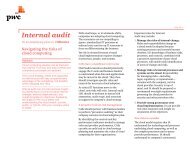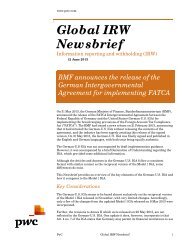Guide to key performance indicators - PwC
Guide to key performance indicators - PwC
Guide to key performance indicators - PwC
Create successful ePaper yourself
Turn your PDF publications into a flip-book with our unique Google optimized e-Paper software.
Reconciliation <strong>to</strong> GAAP<br />
Performance indica<strong>to</strong>rs may be<br />
fi nancial or non-fi nancial. Where the<br />
amounts measured are fi nancial,<br />
but are not “traditional” measures<br />
required by accounting standards,<br />
eg GAAP, it is good practice <strong>to</strong><br />
explain any differences.<br />
Trend data (1) Measurement of <strong>performance</strong> in<br />
isolation over a single period does<br />
not provide the reader with very<br />
useful information. An indication of<br />
how <strong>performance</strong> has improved or<br />
worsened over time is much more<br />
valuable in assessing the success of<br />
management’s strategies.<br />
Segmental<br />
Changes in KPIs<br />
Benchmarking<br />
Often KPIs make little sense when<br />
consolidated at group level. In those<br />
instances corporate reporting users<br />
want more detailed segmental<br />
information <strong>to</strong> assess progress<br />
<strong>to</strong>wards specifi c segmental<br />
strategic aims.<br />
Comparability over time is a <strong>key</strong><br />
principle of good corporate reporting.<br />
It is recognised that KPIs may evolve<br />
over time as strategies change or<br />
more information becomes available.<br />
Performance benchmarked against a<br />
relevant external peer group, with an<br />
explanation of why these peers were<br />
chosen, is considered extremely<br />
valuable <strong>to</strong> users.<br />
A reconciliation should therefore<br />
be provided between accounting<br />
measures and non-GAAP measures.<br />
It is also benefi cial <strong>to</strong> explain <strong>to</strong> the<br />
reader what a particular trend in<br />
the data means – for example, an<br />
increasing measure is not always<br />
a sign of strength – and <strong>to</strong> explain<br />
management’s actions <strong>to</strong> address or<br />
maintain such trends.<br />
Performance indica<strong>to</strong>rs that are<br />
relevant <strong>to</strong> a specifi c segment’s<br />
industry or strategy should therefore<br />
be provided in addition <strong>to</strong> those with<br />
a more group-wide focus.<br />
When such changes are made <strong>to</strong> the<br />
KPIs being moni<strong>to</strong>red, either in terms<br />
of the KPIs used or how they are<br />
calculated, these changes need <strong>to</strong><br />
be explained.<br />
This provides a clear indication<br />
of who management believes the<br />
company’s competi<strong>to</strong>rs <strong>to</strong> be, as<br />
well as setting the company’s own<br />
<strong>performance</strong> in the context of a<br />
well-defi ned peer group.<br />
Note: (1) According <strong>to</strong> the ASB’s Reporting Statement, this information is also recommended disclosure for <strong>performance</strong> indica<strong>to</strong>rs other than KPIs.<br />
9

















